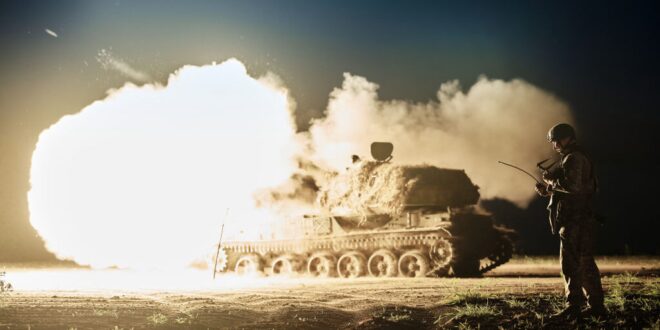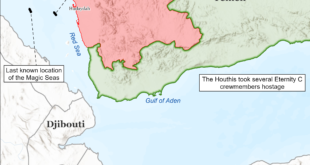As the bold Ukrainian assault into Kursk Oblast enters its third week, the general mood in the West is one of triumph. The offensive, we’re told, vindicates the wisdom of the transatlantic liberal establishment in supporting Kyiv. Suddenly, a Russian victory no longer seems inevitable.
The truth, however, is that the Kursk incursion does not fundamentally alter the reality on the ground: this conflict is one of attrition, which, in the long run, still favours the larger power over the smaller. Rather than celebrate, then, Kyiv’s allies, in particular the United States, would be wise to use this turn of fortune as pretext to pressure both sides into seeking an end to the war — the better for Washington to be able to pursue its own larger strategic interests.
But how might it achieve this? Whether Democrat or Republican, the incoming administration will preside over a four-year period which could see the return of peace in Europe and the opportunity to shape the terms of a settlement with the Kremlin. Given intensifying competition with China and the unthinkable consequences entailed by an American defeat, US leadership would be remiss if it did not treat this eventuality as a cue to shift the balance of power. Or, as the prescient John J. Mearsheimer explained in 2022: “If you live in a world where there are three great powers — China, Russia, and the United States — and one of those great powers, China, is a peer competitor, what you want to do if you’re the United States is have Russia on your side of the ledger.”
Such a scenario would recall the foreign policies of two past presidents. First, it would represent a “reverse Nixon” in which Washington tries to cleave Russia away from China as Richard Nixon and Henry Kissinger cleaved Maoist China from the Soviet Union; and second, an attempt to enact a far more successful version of Barack Obama’s ill-fated Russia Reset. This time, however, the stakes are higher and the circumstances much more difficult than both scenarios, given the strong alliance between Russia and China. Yet insights from history can always be adapted to forge a fitting strategy for the current situation: the question is how?
Most obviously, a negotiated settlement in the form of an armistice — akin to that which ended the Korean War, in which the fighting ceased without definitive recognition of the belligerent’s competing territorial claims — may serve as an expedient conclusion to the war. The two sides could be made to return to something close to pre-2022 ante, which would regrettably allow continuing Russian control over Crimea and rule out the prospect of Nato membership for Kyiv, yet would preserve the existence of a sizeable and sovereign Ukrainian state. Such an outcome would please no one, but at the very least Putin’s ambition of conquering the whole of Ukraine would have been thwarted. There is also a parallel here with Nixon’s strategy when the Republic of China on Taiwan, formerly a key ally, had to be relegated in importance, as Ukraine may soon be, before the larger strategic goal of courting Beijing.
But will this be enough? After all, the US must prepare for the prospect of a long reset, one that will take more than just pressing a shiny button, as Hillary Clinton seemed to want to do, or even more than a future president’s visit to the Kremlin to shake hands with Putin, as with Nixon and Mao. This is because, as noted, unlike in 1972, when ideological differences in the Sino-Soviet Split kept the two communist giants apart, Putin’s Russia and Xi’s China are today in the midst of a so-called “partnership without limits”, which had been declared at a meeting between the two in early 2022. Just as the Biden administration has attempted to characterise the current geopolitical situation as a confrontation between democracies and autocracies, so too have Putin and Xi christened their bond as a bulwark against Western liberal hegemony.
“The US must prepare for the prospect of a long reset, one that will take more than just pressing a shiny button.”
In other words, anti-Americanism is the glue that holds their informal alliance together; yet take that particular element out of the equation and the picture of Sino-Russian friendship begins to look a lot more uncertain. This is because Russia and China are not natural allies and there are a number of vulnerabilities underlying their relationship that an intelligent American geostrategy can exploit:
To begin with, a longstanding sense of mistrust has persisted between these very distinct civilisations with sparse people-to-people ties, who are separated from each other by a vast 2,568-mile militarised border. There is also the aspect of ressentiment that arises out of any asymmetrical relationship: Russia, previously the dominant partner, has been relegated to junior status, and is now far more dependent on China for investment than the other way around. Even as Moscow leans into integration with China as a way to make up for lost Western trade, Chinese interest in Russia’s natural gas and industrial inputs is belied by Beijing’s strategy of diversifying energy and resource markets, such as through large investments in renewables. Unsurprisingly, Chinese investment in Russian pipeline projects in Siberia has fallen short of expectations. China also relied on Russia for its cheap weapons exports but has since become self-sufficient with the maturation of its own arms industries.
Meanwhile, resource-rich Central Asia has also seen expansion of Chinese presence, through Beijing’s Belt and Road Initiative (BRI), which would link the landlocked former Soviet republics there into a broader Chinese-dominated trade order. Russia officially supports this and Putin has been a major presence at BRI summits, yet Moscow has struggled to sustain its own integration efforts with the Eurasian Economic Union, which has flailed since its launch in 2015 as a vehicle for the reassertion of Russian influence in an area it still sees as its sphere of influence.
A new American strategy toward Russia for the latter half of the 2020s and beyond would seize on these weak spots in Sino-Russian relations. It would call for the progressive lifting of sanctions and gradual reintegration of Russia into Western trade, finance, and energy markets, alongside channelling Western capital into Russia to address its critical investment gaps in technology and infrastructure.
This is, of course, easier said than done. While Russian elites will only be too happy to be allowed back into the West’s banks and luxury shopping malls, the Russian state, whether under an ageing Putin or his successor, will likely be far more cautious, if not wary; Moscow will no doubt try to play off the Americans and Chinese against each other while benefiting from the largesse of both.
This will call for strategic patience on the part of Washington, which should aim to manage the residual tensions between the Kremlin and European allies, while encouraging Moscow to begin to assert itself against China in Central Asia. The US can also aim to integrate Russia with the bloc of Indo-Pacific states it is assembling — by, for instance, brokering deals and securing new customers for Russian energy and arms among the rising Indo-Pacific powers, whose defence capabilities the US is already looking to bolster as a counter to China’s growing military might.
A renewed Russo-American entente, however, would be most fruitful in a region that will only become more important in the decades ahead, namely the Arctic, where receding ice coverage will open new zones for shipping and resource exploration. China and Russia have worked towards the establishment of a “Polar Silk Road” which would give Beijing a presence in the polar north, where otherwise it would have none. The US should aggressively try to head off this possibility by making it a paramount strategic goal to ensure a “China-free Arctic”. It can only do this, however, if it can eventually convince the Russians to substitute Chinese for Western capital and technical assistance as a means of developing this vast untapped frontier. The best-case scenario would be to have an Arctic maritime trade region, managed exclusively by Russia and the Western Arctic powers, to bypass China’s BRI, through which certain resources and goods can be traded across continents without touching Chinese-controlled infrastructure.
At a time of severe tension between Russia and the West, such projections may seem fantastical. But stranger things have happened: China’s transition from the most fanatically anti-American power to Washington’s partner was Nixon’s great feat, and the next president can start to do the same with Russia. With his expressed desire for mending ties with Moscow, Donald Trump would seem best suited to enact such a policy, but a Harris-led reproachment would actually embody the analogy better, since it was the dramatic turnaround after years as a Cold War hawk that made Nixon’s gambit such a political masterstroke: “Only Nixon can go to China,” as the saying went. One wonders if Kamala Harris can pull off a comparable pivot.
Only now, Americans will have to forgo the liberal triumphalism that proved to be so naïve in the recent past. Russia will likely persist as a distinct world civilisation and must be treated as such, even if it means countenancing its perennially illiberal forms of government. For the question of the next half-century will not be whether American political norms shall triumph over the earth, but whether America itself can survive this coming era of great power competition; and in this race, values must give way to interests and woolly-headed idealism to the coldest realism.
 Eurasia Press & News
Eurasia Press & News


